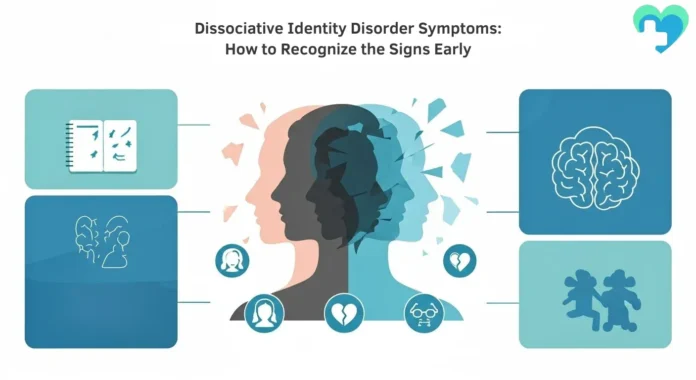An abstract for recognizing the early signs of Dissociative Identity Disorder (DID) would cover key symptoms such as identity fragmentation, amnesia, and detachment. Early signs can be subtle and are often observed in children who have experienced significant trauma. The condition, formerly known as multiple personality disorder, is a complex psychological response to trauma.
Recognizing Dissociative Identity Disorder (DID) in real life isn’t as simple as spotting someone calling themselves “We.” It’s often subtle, quiet, and painfully misunderstood. In movies, DID looks like someone flipping personalities every two minutes with dramatic lighting. It’s usually someone looking exhausted because they don’t know why half their day feels missing.
What is Dissociative Identity Disorder Symptoms
Dissociative identity disorder (DID), once known as multiple personality disorder, is characterized by two key symptoms: the presence of multiple, distinct identities and persistent gaps in memory. These symptoms, which often stem from severe childhood trauma, can significantly disrupt a person’s life.
Identity related symptoms:
- Distinct identities (“alters”): A person with DID experiences at least two separate and unique personality states. These identities can have different names, personal histories, mannerisms, voices, and even physical characteristics, such as vision or posture.
- Sudden “switching”: The person may suddenly and involuntarily shift between these identities, especially when under stress. This change in personality can be noticed by others and may include a different outlook, mood, or set of skills.
- Feelings of detachment: The individual may feel like an outside observer of their own life, as if watching a movie of themselves (depersonalization). They might also feel that the world around them is unreal or distorted (derealization).
- Identity confusion: A person with DID may have a blurred sense of who they are, their beliefs, and their personal history.
Memory Gaps That Don’t Make Sense
One of the earliest and most common symptoms of DID is dissociative amnesia but not the “I forgot where I put my keys” kind. It’s more like:
- “Why are there groceries in my fridge I don’t remember buying”
- “Why is my phone full of photos of places I don’t remember visiting”
People with DID often lose time, a phenomenon casually called time skipping. Hours, days, or even weeks may go missing without explanation. Unlike regular forgetfulness, these gaps aren’t caused by stress or distraction they’re caused by switching between identities, or alters, without conscious awareness.
Emotional Reaction That Don’t Feel Like Your Own
DID isn’t just about memory. It’s also about feeling emotions that don’t match the moment or even your personality.
Someone with DID might react with extreme anger to a harmless joke or suddenly cry in a situation where nothing sad is happening. It’s not random; it’s usually an alter reacting based on past trauma rather than present reality.
This emotional inconsistency is often mistaken for mood disorders, which is why DID is frequently misdiagnosed as bipolar disorder or borderline personality disorder.
| Type of Internal Voice | Experience | Common in DID |
| Regular Inner Monologue | “Hmm, I should make coffee.” | No |
| DID Identity Dialogue | “We picked coffee yesterday. Let’s have tea.” | Yes |
| Psychotic Hallucination | “The toaster is telling me to jump.” | No |
Identity Shifts That Seem Like “Acting Different”
Not all identity switches in DID are obvious. Hollywood portrays dramatic shifts, but real life DID often involves micro-switches subtle changes in voice, posture, vocabulary, or handwriting.
A person may suddenly:
- Use slang they normally wouldn’t.
- Eat foods they usually hate.
- Change handwriting style mid-sentence.
In early stages, these signs often get dismissed as “quirky” or “inconsistent personality.” But when these shifts come with memory gaps and emotional disconnects, they point to DID rather than ordinary mood changes.
Physical Changes That Don’t Add Up
Yes identity shifts can even affect the body.
One alter may need glasses, while another doesn’t. One may be allergic to strawberries, and another may eat them without issues. Science calls this psychosomatic variance. Most doctors call it “weird.” But in DID, it’s common.
Here’s a second helpful comparison table:
| Physical Change | Normal Variation | Possible DID Indicator |
| Occasional clumsiness | Tripping sometimes | “Why are there bruises I don’t remember getting?” |
| Handwriting variation | Slight inconsistencies | Entirely different signature styles on different days |
| Different food cravings | Mood-based | Strong preferences changing within hours without reason |
Zoning Out Dissociating Without Realizing It
Everyone daydreams. But people with DID often fully detach from reality without intending to. These episodes can last minutes or hours, and during them, the body keeps functioning while the mind disappears.
- Staring into space for an hour and “waking up” without knowing what happened.
- Driving somewhere and realizing you don’t remember the trip.
- Having conversations you don’t recall participating in.
Early Signs in Childhood Often Ignored
Most people with DID develop it as a response to severe childhood trauma. Early symptoms usually appear in childhood but are often dismissed. Kids with early DID may:
- Have “imaginary friends” who seem unusually real.
- Talk about “we” instead of “I”.
- Blame actions on “someone else” not as an excuse, but genuinely confused.
These signs are frequently misunderstood as creativity or behavioral issues, which delays diagnosis well into adulthood.
Why DID Is So Often Misdiagnosed
Many people with DID spend years in therapy before getting the correct diagnosis. They’re often misdiagnosed with:
- Bipolar Disorder (due to mood swings)
- ADHD (due to distractibility and lost time)
- PTSD (due to trauma history which can overlap)
FAQs
Q1: Can someone have DID without dramatic personality changes?
Yes. Most people with DID function highly in society. Their symptoms are often hidden.
Q2: Is DID the same as schizophrenia?
No. Schizophrenia involves hallucinations and delusions. DID involves distinct identity states, often without psychosis.
Q3: Can DID be cured?
Not cured, but managed. With therapy, alters can communicate better and work as a team.
Q4: Is switching between alters always obvious?
Not at all. Some switches are seamless even the person may not notice.
Final Thoughts
Dissociative Identity Disorder isn’t loud, dramatic, or theatrical it’s quiet, confusing, and often hidden in plain sight. It doesn’t always show up as a “different voice” or a sudden transformation like movies suggest. Sometimes, it’s missed time. Sometimes, it’s emotions that feel borrowed. Sometimes, it’s a life lived in fragments.


